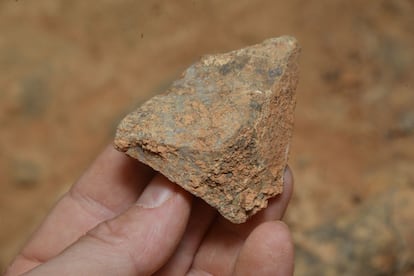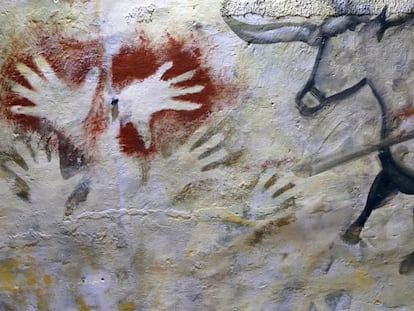New discovery fills gap in Atapuerca’s history of human evolution
Two stone tools found in the world-famous archeological site in northern Spain provide answers about its early inhabitants

Two sharp quartzite stones carved by a hominid 600,000 years ago have just provided the missing piece of the puzzle at the Atapuerca archeological site in Burgos, in northern Spain. While small in size, the find provides evidence of an uninterrupted human presence in the area from 1.4 million years ago to the present day.
“Thanks to this discovery, Atapuerca is the only site that can tell the entire history of human evolution in Europe with all of its human species,” says paleoanthropologist María Martinón-Torres, director of the National Research Center on Human Evolution and a veteran at the Burgos site. “These are precisely the pieces we needed to complete the puzzle.”
I don’t think there is any other site in the world where all the human species to inhabit Europe have been foundMaría Martinón-Torres, director of the National Research Center on Human Evolution
Experts had long been stumped by the sudden lack of evidence of hominids in Atapuerca spanning hundreds of thousands of years. The first human fossils found here date back 1.2 million years and belong to an unidentified primitive hominid, although there are stone tools that date back as far as 1.4 million years.
Then, 850,000 years ago, a completely new species appeared: Homo antecessor, whose fossils and tools have been unearthed along with the remains of his carnivorous meals, both animal and human. Subsequently, there is a mysterious interim with no evidence of a human presence until the pre-Neanderthals arrived about 400,000 years ago. “What happened?” says Martinón-Torres. “Did they abandon the cave; did its roof collapse? Had the humans left or did we not know how to find them?”

Like H. antecessor’s artifacts, the two new tools were found at the Gran Dolina dig, in strata corresponding to between 500,000 and 600,000 years ago. Used for cutting meat, these tools build a bridge linking the H. antecessor period with that of the new hominids – the pre-Neanderthals whose remains were found in another part of the site known as the Sima de los Huesos (Pit of the Bones).
Later, around 110,000 years ago, the Neanderthals were already fully formed as a species at Atapuerca, as evidenced by the remains of a toe and tools found in the Statues Gallery. There they remained until about 40,000 years ago, when their entire species was wiped out. Finally, Homo sapiens showed up, occupying the area from the Neolithic period, around 7,000 years ago, until the present day.
“I don’t think there is any other site in the world where all the human species to inhabit Europe have been found: pre-Homo antecessor, Homo antecessor, pre-Neanderthals, Neanderthals and Homo sapiens,” says Martinón-Torres.
English version by Heather Galloway.
Tu suscripción se está usando en otro dispositivo
¿Quieres añadir otro usuario a tu suscripción?
Si continúas leyendo en este dispositivo, no se podrá leer en el otro.
FlechaTu suscripción se está usando en otro dispositivo y solo puedes acceder a EL PAÍS desde un dispositivo a la vez.
Si quieres compartir tu cuenta, cambia tu suscripción a la modalidad Premium, así podrás añadir otro usuario. Cada uno accederá con su propia cuenta de email, lo que os permitirá personalizar vuestra experiencia en EL PAÍS.
¿Tienes una suscripción de empresa? Accede aquí para contratar más cuentas.
En el caso de no saber quién está usando tu cuenta, te recomendamos cambiar tu contraseña aquí.
Si decides continuar compartiendo tu cuenta, este mensaje se mostrará en tu dispositivo y en el de la otra persona que está usando tu cuenta de forma indefinida, afectando a tu experiencia de lectura. Puedes consultar aquí los términos y condiciones de la suscripción digital.
More information
Últimas noticias
There is as much life left to discover on planet Earth as that which is already known
Dozens presumed dead, around 100 injured in fire at Swiss Alps bar during New Year’s celebration
Is porn for women different from conventional porn? We spoke to those who make it
Cartagena de Indias is sinking: What can the city do to mitigate it?
Most viewed
- Reinhard Genzel, Nobel laureate in physics: ‘One-minute videos will never give you the truth’
- David King, chemist: ‘There are scientists studying how to cool the planet; nobody should stop these experiments from happening’
- Oona Chaplin: ‘I told James Cameron that I was living in a treehouse and starting a permaculture project with a friend’
- Sinaloa Cartel war is taking its toll on Los Chapitos
- The Interoceanic Train, the Mexican alternative to the Panama Canal











































